
Sometimes you see calculators with solar cells. These calculators do never need batteries as long as
there is enough light. You also once may have seen larger solar panels for example on emergency
road signs, roofs or in gardens to power light sources. Although these larger panels are not as
common as solar powered calculators, they are out there and not hard to find if you know where to
look.
Converting Photons to Electrons
The solar cells in calculators and satellites are photovoltaic cells. A solar module is a group of cells,
electrically connected in one frame. Photovoltaics is a combination of the two words Photo and
Voltaic. Photo = light and voltaic = electricity.
Photovoltaic (PV) cells are made of special materials called semiconductors. This is the same
material where IC‘s Integrated Circuits, transistors, LED‘s, phototransistors and IR receivers are
made of. Silicon is currently the most commonly used material to make semiconductors and also
solar cells.
Making electricity out of light
When enough light hits the solar cell, a certain percentage
will be absorbed within the semiconductor material.
Now the absorbed light energy is transferred to the
semiconductor. This energy hits some electrons.
The electrons will move around freely.
When electrons move around, there is always a current.
This current will be transported through conductors,
which can be copper or silver plates on the top and
bottom of the solar cell.
Now it can be transported further by electrical wire and used in an apparatus like a calculator or lamp
or it can be stored in a battery.
Current (I), together with the cell’s
voltage (U) is a result of its built-in
electric field, defines the power (P) which
is also called Wattage
P=U x I
Wattage is the total power a solar cell
can produce.
Specifications of a solar cell can be:
I = current (Ampére, or mostly in
milli Ampére (1mA = 0,001A)
U = voltage (Volt)
P = power (Watt)
Not much light and the electrons are in rest
Lots of light and the electrons are moving
How does a SOLAR CELL work?
English






























